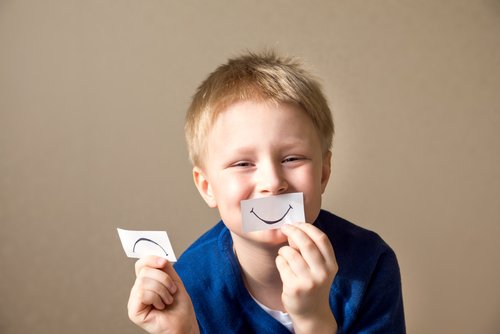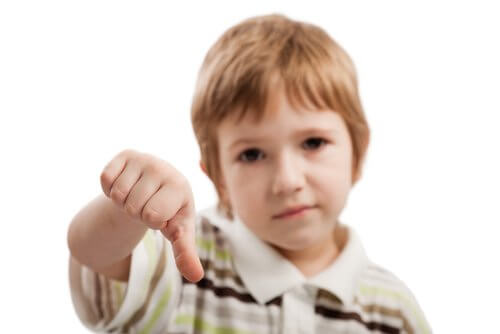How to Help Children Channel Their Emotions

Our children’s education starts at home, and goes far beyond technical and factual knowledge. A child’s education is also based on values such as responsibility and respect. Through these values, and others, parents can help their children channel their emotions.
Parenting is something that we learn to do well as we go. Most first-time parents don’t have experience regarding emotional education and management from the start. However, when we have children, it’s time to look for the tools to help develop these abilities in our children.
A range of emotions
From the first days of life, children give free rein to their emotional expression. For example, they’ll cry when they feel uncomfortable, hungry or tied.
Likewise, they’ll smile and giggle when they like something. If something catches their attention or surprises them, the wonder is evident on their faces.
However, over time and through their personal experiences, children come to know new emotions that are less positive. For example, children start to experience feelings of frustration when they can’t achieve something they’ve set their minds to.
Or, they feel anger when they don’t get what they want, when they want it. And they may even experience feelings of embarrassment or pride.
Furthermore, children express sadness when they lose something that is valuable to them, and fear in the face of intimidating or unfamiliar situations. Therefore, adults need to be attentive and open to any tool that can help little ones channel their emotions.
Why does my child have tantrums?
Many times, children feel overwhelmed by their emotions and don’t know how to express them or channel them. When this occurs, they often end up having tantrums, at home and in public.
These tantrums are their way of expressing their emotions or imposing their authority. With this attitude, they not only produce unpleasant moments for their parents, but also consequences for themselves.

The emotions mentioned above aren’t the emotions that can cause children to become overstimulated. Even the excitement of accomplishing their goals or the arrival of a much-anticipated moment can produce a total internal revolution, and also lead to tantrums.
These feelings can manifest themselves through shouting, jumping and racing around. Depending on the setting and the circumstances, these actions may come off as inappropriate.
Of course, in the future, you want your children to be able to handle themselves in society, school and work without difficulties. Therefore, you need to learn to handle these emotional explosions early on. That means that helping your children handle their emotions adequately must be a priority.
Steps to follow to help children channel their emotions
1. Allow them to express themselves
The goal isn’t to teach our children to repress their emotions instead of expressing them. Rather, let children release what they feel inside. Observe how they go about it and correct promptly if you notice they’re on the wrong path.
If the only mechanism children have to express themselves is through protests and uncontrolled crying, it’s time to take action. This is a clear sign you need to help your children channel their emotions.
Understand your child
When a child expresses a certain feeling or emotion, there must be some reason behind it. Many times, children don’t know how to express just what’s going on inside.
Therefore, parents must learn to read their body language and quickly recognize what’s affecting them. That way, you can be one step ahead of any situation.
Help them understand what’s happening to them
Children aren’t born with emotional education. It’s our job as adults to help them identify the feelings they’re experiencing, and then teach them actions to manage them.
Once you’ve identified the emotion your children are trying to express, invite them to practice some actions that will help them stay calm. For example, ask them to take a seat, count to ten, breathe deeply, etc.

Promote self-control and autonomy
Once children are calm, you can speak calmly with them. Always inquire about what they think and how they believe they can solve the situation.
Depending on their responses, you should orient their actions and invite them to solve the issue themselves, calmly. Achieving self-control over their emotions will help them build independence and autonomy.
Emotional education helps children fully enjoy different experiences throughout their lives. In the same way, it helps them cope positively in difficult situations, rather than blaming others for their negative feelings.
In the end, children who know how to channel their emotions manage to live happier lives and communicate better with those around them.
Our children’s education starts at home, and goes far beyond technical and factual knowledge. A child’s education is also based on values such as responsibility and respect. Through these values, and others, parents can help their children channel their emotions.
Parenting is something that we learn to do well as we go. Most first-time parents don’t have experience regarding emotional education and management from the start. However, when we have children, it’s time to look for the tools to help develop these abilities in our children.
A range of emotions
From the first days of life, children give free rein to their emotional expression. For example, they’ll cry when they feel uncomfortable, hungry or tied.
Likewise, they’ll smile and giggle when they like something. If something catches their attention or surprises them, the wonder is evident on their faces.
However, over time and through their personal experiences, children come to know new emotions that are less positive. For example, children start to experience feelings of frustration when they can’t achieve something they’ve set their minds to.
Or, they feel anger when they don’t get what they want, when they want it. And they may even experience feelings of embarrassment or pride.
Furthermore, children express sadness when they lose something that is valuable to them, and fear in the face of intimidating or unfamiliar situations. Therefore, adults need to be attentive and open to any tool that can help little ones channel their emotions.
Why does my child have tantrums?
Many times, children feel overwhelmed by their emotions and don’t know how to express them or channel them. When this occurs, they often end up having tantrums, at home and in public.
These tantrums are their way of expressing their emotions or imposing their authority. With this attitude, they not only produce unpleasant moments for their parents, but also consequences for themselves.

The emotions mentioned above aren’t the emotions that can cause children to become overstimulated. Even the excitement of accomplishing their goals or the arrival of a much-anticipated moment can produce a total internal revolution, and also lead to tantrums.
These feelings can manifest themselves through shouting, jumping and racing around. Depending on the setting and the circumstances, these actions may come off as inappropriate.
Of course, in the future, you want your children to be able to handle themselves in society, school and work without difficulties. Therefore, you need to learn to handle these emotional explosions early on. That means that helping your children handle their emotions adequately must be a priority.
Steps to follow to help children channel their emotions
1. Allow them to express themselves
The goal isn’t to teach our children to repress their emotions instead of expressing them. Rather, let children release what they feel inside. Observe how they go about it and correct promptly if you notice they’re on the wrong path.
If the only mechanism children have to express themselves is through protests and uncontrolled crying, it’s time to take action. This is a clear sign you need to help your children channel their emotions.
Understand your child
When a child expresses a certain feeling or emotion, there must be some reason behind it. Many times, children don’t know how to express just what’s going on inside.
Therefore, parents must learn to read their body language and quickly recognize what’s affecting them. That way, you can be one step ahead of any situation.
Help them understand what’s happening to them
Children aren’t born with emotional education. It’s our job as adults to help them identify the feelings they’re experiencing, and then teach them actions to manage them.
Once you’ve identified the emotion your children are trying to express, invite them to practice some actions that will help them stay calm. For example, ask them to take a seat, count to ten, breathe deeply, etc.

Promote self-control and autonomy
Once children are calm, you can speak calmly with them. Always inquire about what they think and how they believe they can solve the situation.
Depending on their responses, you should orient their actions and invite them to solve the issue themselves, calmly. Achieving self-control over their emotions will help them build independence and autonomy.
Emotional education helps children fully enjoy different experiences throughout their lives. In the same way, it helps them cope positively in difficult situations, rather than blaming others for their negative feelings.
In the end, children who know how to channel their emotions manage to live happier lives and communicate better with those around them.
All cited sources were thoroughly reviewed by our team to ensure their quality, reliability, currency, and validity. The bibliography of this article was considered reliable and of academic or scientific accuracy.
- Bisquerra, R. (2011). Educación emocional. Propuestas para educadores y familias. Bilbao: Desclée de Brower. http://otrasvoceseneducacion.org/wp-content/uploads/2019/04/Educación-Emocional.-Propuestas-para-educadores-y-familias-Rafael-Bisquerra-Alzina-2.pdf
- Bisquerra, R. (2016). Universo de emociones: la elaboración de un material didáctico. Reflexiones, experiencias profesionales e investigaciones, 20, 1-860. https://dialnet.unirioja.es/descarga/libro/655308.pdf
- Goleman, D. (2010). La práctica de la inteligencia emocional. Editorial Kairós.
- Huayamave, K. G., Benavides, B. B., & Sangacha, M. M. (2019). Estudio del rol de los padres de familia en la vida emocional de los hijos. Apuntes Universitarios. Revista de Investigación, 9(2), 61-72.
- Jeta, P. M. P. A. (1998). El desarrollo emocional infantil (0-6 años): Pautas de educación. In Ponencia presentada en el congreso de Madrid. España. http://www.waece.org/biblioteca/pdfs/d069.pdf
- López, M. (2008). La integración de las habilidades sociales en la escuela como estrategia para la salud emocional. Psicología sin fronteras: revista electrónica de intervención psicosocial y psicología comunitaria, 3(1), 16-19.
- Losada, A. V., Estevez, P., & Caronello, T. (2020). Estilos Parentales y Autorregulación Emocional Infantil Revisión Narrativa de la literatura. Revista REDES, (40). http://redesdigital.com.mx/index.php/redes/article/view/286/6783461
- Marina, J. A. (2013). Límites, disciplina, castigos. Pediatría Integral, 17(7), 520-524. https://maisonbuissonniere.org/wp-content/uploads/2021/04/520-524-Brujula-7-dolto.pdf
- Ramírez-Lucas, A., Ferrando, M., & Sainz, A. (2015). ¿ Influyen los estilos parentales y la inteligencia emocional de los padres en el desarrollo emocional de sus hijos escolarizados en 2º ciclo de educación infantil?. Acción psicológica, 12(1), 65-78. https://scielo.isciii.es/scielo.php?script=sci_arttext&pid=S1578-908X2015000100007
- Shapiro, L. E. (2002). La salud emocional de los niños (Vol. 16). Edaf.
This text is provided for informational purposes only and does not replace consultation with a professional. If in doubt, consult your specialist.








